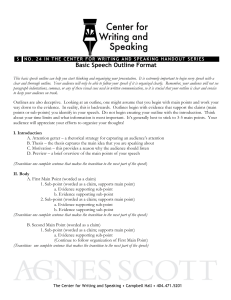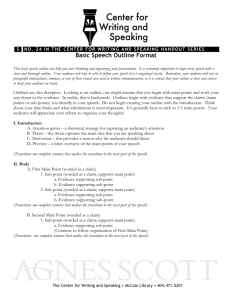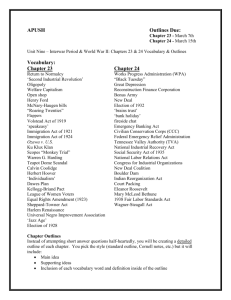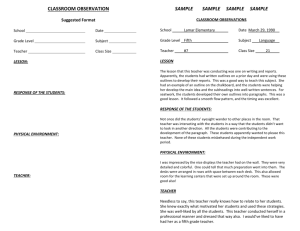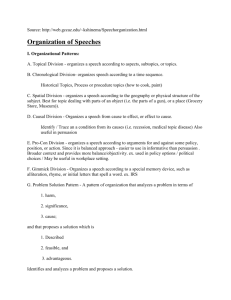Outlining Your Speech
advertisement
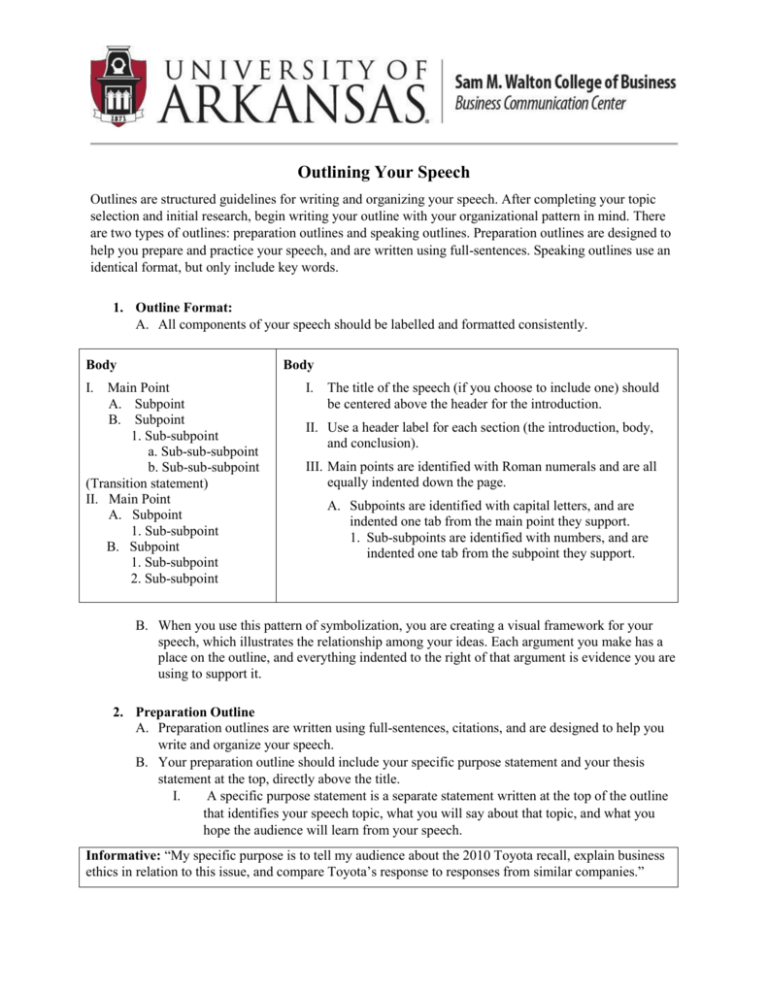
Outlining Your Speech Outlines are structured guidelines for writing and organizing your speech. After completing your topic selection and initial research, begin writing your outline with your organizational pattern in mind. There are two types of outlines: preparation outlines and speaking outlines. Preparation outlines are designed to help you prepare and practice your speech, and are written using full-sentences. Speaking outlines use an identical format, but only include key words. 1. Outline Format: A. All components of your speech should be labelled and formatted consistently. Body I. Body Main Point A. Subpoint B. Subpoint 1. Sub-subpoint a. Sub-sub-subpoint b. Sub-sub-subpoint (Transition statement) II. Main Point A. Subpoint 1. Sub-subpoint B. Subpoint 1. Sub-subpoint 2. Sub-subpoint I. The title of the speech (if you choose to include one) should be centered above the header for the introduction. II. Use a header label for each section (the introduction, body, and conclusion). III. Main points are identified with Roman numerals and are all equally indented down the page. A. Subpoints are identified with capital letters, and are indented one tab from the main point they support. 1. Sub-subpoints are identified with numbers, and are indented one tab from the subpoint they support. B. When you use this pattern of symbolization, you are creating a visual framework for your speech, which illustrates the relationship among your ideas. Each argument you make has a place on the outline, and everything indented to the right of that argument is evidence you are using to support it. 2. Preparation Outline A. Preparation outlines are written using full-sentences, citations, and are designed to help you write and organize your speech. B. Your preparation outline should include your specific purpose statement and your thesis statement at the top, directly above the title. I. A specific purpose statement is a separate statement written at the top of the outline that identifies your speech topic, what you will say about that topic, and what you hope the audience will learn from your speech. Informative: “My specific purpose is to tell my audience about the 2010 Toyota recall, explain business ethics in relation to this issue, and compare Toyota’s response to responses from similar companies.” Persuasive: “After my speech, my audience will know the effects and importance of a staffing system on organizational development, and what actions they can take to reduce costs while increasing employee retention, production, and quality of work within their companies.” II. Your thesis statement is a single statement that explicitly states the main argument, or goal of your speech, to your audience. Informative: “Today, as a case study for understanding business ethics, I will tell you about Toyota’s voluntary recall of several thousand vehicles in 2010, and how their response to the situation differed from previous vehicle manufacturers that faced similar problems.” Persuasive: “In this speech, I argue that staffing systems are vital to the success of organizational development because they increase employee retention, production, and quality of work, while also reducing overall costs to the company.” 3. Speaking Outline A. The speaking outline is written after the preparation outline, and follows the same format. Speaking outlines are used for practicing your speech. B. Speaking outlines use key words, instead of full-sentences, they do not include citations (intext or bibliography), and they do not include the specific purpose or thesis statement at the top. If you are using quotes, however, you should write them out completely for both outlines. C. After practicing your speech by reading from your preparation outline, should begin to practice your speech with the speaking outline. Because the speaking outline only contains key words, you should focus on delivering your speech extemporaneously (conversationally, without memorization). D. If you will be using notecards during your speech, you can write your notecards using your speaking outline. Make sure to number or bind your notecards so that they do not fall out of order. A sample outline is included below. Specific Purpose: (Preparation outline only) Thesis Statement: (Preparation outline only) Title of Speech Introduction I. II. III. IV. Attention-getting device Thesis statement Credibility statement Preview statement (Transition statement) Body I. Main Point A. Sub-point (relates, but is subordinate to main point) 1. Sub-sub-point (relates, but is subordinate to sub-point A) a. Sub-sub-sub point (relates, but is subordinate to sub-sub-point 1) i. Sub-sub-sub-sub point (relates, but is subordinate to sub-sub-sub-point a) 2. Sub-sub-point a. Sub-sub-sub point b. Sub-sub-sub point B. Sub-point 1. Sub-sub-point 2. Sub-sub-point a. Sub-sub-sub point b. Sub-sub-sub point i. Sub-sub-sub-sub point (Transition statement) II. Main Point A. Sub-point B. Sub-point 1. Sub-sub-point a. Sub-sub-sub-point 2. Sub-sub-point a. Sub-sub-sub point i. Sub-sub-sub-sub point ii. Sub-sub-sub-sub point b. Sub-sub-sub point C. Sub-point 1. Sub-sub-point a. Sub-sub-sub point (Transition statement) III. Main Point A. Sub-point 1. Sub-sub-point a. Sub-sub-sub-point b. Sub-sub-sub-point B. Sub-point 1. Sub-sub-point 2. Sub-sub-point a. Sub-sub-sub point i. Sub-sub-sub-sub point ii. Sub-sub-sub-sub point b. Sub-sub-sub point C. Sub-point 1. Sub-sub-point a. Sub-sub-sub point (Transition statement) Conclusion I. II. III. IV. Signpost to begin conclusion Restate thesis Summarize main points Clincher statement Bibliography (Alphabetically by last name, format according to style guidelines)


